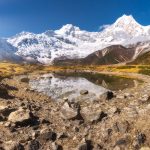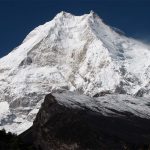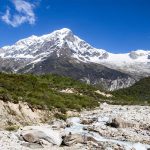Overview
The Manaslu Circuit is a hidden gem in a restricted area and you need specific permits to be eligible to trek here. This provision aims to protect the region’s delicate environment and cultural heritage.
The Manaslu Circuit trek is a 177-kilometer loop and it offers pristine trails, pine-scented air and vibrant Gurung and Tibetan villages with prayer flags. Being here means trekking through Nepal’s Himalayas, with Mount Manaslu’s 8,163-meter peak looming above, its snow glistening in the morning light.
However, unlike the crowded routes of the Everest Base Camp trek or the Annapurna Base Camp trek, it is designated as a restricted area due to its proximity to the Tibet border. It is located in the Manaslu Conservation Area. Thus, the restricted status preserves its untouched landscapes, home to snow leopards, blue sheep and more than 2,000 plant species.

Permits generate funds for activities like trail maintenance and waste management, as well as community projects. Additionally, they also ensure your safety at altitudes above 5,000 meters, where the weather can turn treacherous, as the system mandates a licensed Nepali guide and a minimum of two trekkers per group. Therefore, this isn’t about control — it’s about responsible tourism in a sensitive border region.
Without permits, you face the risk of paying fines, facing deportation or being rejected at checkpoints like Jagat or Sama Gaon. In short, the Manaslu Restricted Area Permit, along with conservation permits, regulates access from Jagat to Dharapani, safeguarding both nature and local traditions.
Likewise, solo trekking is not allowed in the region, thus requiring a registered agency like Radiant Treks.
Ultimately, remember that the Manaslu Circuit trek permits are your ticket to a sustainable and safe adventure. They let you focus on the trek’s raw beauty along with village hospitality.
Highlights
- The Manaslu Circuit lies in a restricted area, so special permits are a must
- You’ll need three main permits — Manaslu Restricted Area Permit, Manaslu Conservation Area Permit and Annapurna Conservation Area Permit — to complete the full loop
- Solo trekking isn’t allowed, and you must hike with a licensed guide and an agency
- Restricted Area Permit costs change by season — usually pricier in autumn, cheaper in winter and summer
- If you add Tsum Valley, you will need two extra permits for that side trip
- Permits are checked at several points, like Jagat, Philim and Sama Gaon
- Always carry printed copies of your permits and passport during the trek
Permits Required for Manaslu Circuit Trek
If you want to go on the trek of the Manaslu Circuit without any detour, you’ll need three permits. Each permit has a different purpose and covers different sections of the trek. They are like layers of access to the Manaslu region. One of the permits is for the restricted border region. Two other permits are necessary for walking in the Manaslu Conservation Area.
Here’s the breakdown of the permits.

Manaslu Circuit Restricted Area Permit (RAP)
This is the key to accessing the core restricted zone of Manaslu. Nepal’s Department of Immigration in Kathmandu issues this permit. The RAP is essential from Jagat to Dharapani, where the trail skirts sensitive border regions.
This trek permit has a goal of monitoring and limiting visitor numbers in the Manaslu region. Eventually, it aims to prevent overcrowding. At the same time, protecting local cultures and environments from unchecked tourism is another objective.
Moreover, it is not possible to obtain this permit independently. You need to apply for this permit through a registered agency. Radiant Treks specializes in applying for and obtaining this permit for those planning the Manaslu Circuit Trek.
The permit includes details, like your group’s composition, information about the guide and exact trip dates. As such, this permit is personalized and cannot be transferred. Without this permit, therefore, you cannot get past the first checkpoint in the Manaslu region.

Manaslu Conservation Area Permit (MCAP)
Managed by the National Trust for Nature Conservation (NTNC), the MCAP kicks in around Philim and covers the bulk of the Manaslu area up to Sama Gaon.
This permit focuses on environmental stewardship. Specifically, you can think of the funds being used for activities like anti-poaching patrols, reforestation and waste management in the Manaslu region, which is a biodiversity hotspot.
The fee also supports initiatives to keep the trails clean and the wildlife thriving. You can also see eco-friendly teahouses and community-run projects along the way. They are the outcome of the best utilization of the permit fees.
It’s easier to obtain than RAP and you can get it directly at NTNC offices or via Radiant Treks as well. Alternatively, you can apply it online as well. Like RAP, it is also non-transferable and non-refundable.
Therefore, you need to plan your trekking dates and itinerary carefully so as to align with the permit dates. Also, remember the entry permit is valid only for single entries.

Annapurna Conservation Area Permit (ACAP)
Despite the unique nature of Manaslu, the trek frequently passes through Dharapani in the Annapurna region. That’s where the use of this permit comes in. NTNC issues this permit as well. Therefore, you need it for that final stretch of the trek. And obtaining one is necessary for a seamless transition throughout the journey without backtracking.
Like the MCAP, it’s also about conservation. In fact, the permit fees are used to protect the Annapurna area’s rivers, forest and cultural sites. If your itinerary skips Dharapani (rare, but possible with variations), you might not need this, but most standard routes do.
Altogether, these permits work together to create a controlled, responsible trekking experience. Totaled up, they’re not cheap, but they are a small price for accessing one of Nepal’s most untouched corners.
Additional Permits for Tsum Valley Side Trip
The Manaslu Circuit is an epic in itself and provides a complete adventure experience for trek enthusiasts. Nevertheless, many trekkers add the Tsum Valley extension for an extra dose of magic. They include ancient monasteries, sacred caves and a frozen valley with strong Tibetan vibes. If that’s your plan, then you’ll need two more permits on top of the basics.
Tsum Valley Restricted Area Permit
Similar to the Manaslu RAP, the Department of Immigration issues this one, too. It covers the trek route from Chumling to Mu Gompa. Meanwhile, this area is restricted so as to safeguard the valley’s religious sites and nomadic herder lifestyles from mass tourism.
You need to apply for the permit through Radiant Treks alongside the main RAP. The process of obtaining this permit is simple but mandatory.

Chumnubri Rural Municipality Permit
This is a tourism fee charged to provide the permit if you want to trek in the Tsum Valley. The Chumnubri Rural Municipality Office levies this fee for the trekkers’ hiking in the area.
It’s essentially a community development tax. It is used to fund schools, health posts and infrastructure in the area. You can obtain the permit by paying the fee on-site in Nepali rupees. Your guide with Radiant Treks handles the details.
Manaslu Circuit Trek Permit Cost Table

Now that you know about the permits, you are probably wondering about the Manaslu Circuit trek permit fees. But the permits are not just entry tickets. They also keep the border region sustainable by funding everything from trail repairs to local wildlife protection.
The costs of trek permits can shift slightly with exchange rates or minor policy tweaks. These rates apply per person for foreign nationals (non-SAARC). SAARC country citizens get discounts. So, before starting your trek, confirm with us at Radiant Treks as we handle the processing.
Here is a clear breakdown of the permit cost.
Manaslu Circuit Trek Permit Cost
| Permits and Details | Cost, Validity and Remarks |
| Manaslu Restricted Area Permit (RAP) Issuing Office: Department of Immigration Validity / Zone: Jagat to Dharapani (restricted zone) | Cost (USD)Sep to Nov: $100 for the first 7 days, plus $15/day extra Dec to Aug: $75 for first 7 days, plus $10/day extra Remarks: Mandatory and can be obtained only via licensed agency. Minimum 2 trekkers with a guide needed. |
| Manaslu Conservation Area Permit (MCAP) Issuing Office: NTNC Validity / Zone: Entire Manaslu Conservation Area (from Philim onward) | Cost (NPR): Rs. 3,000 per person Remarks: Supports biodiversity and conservation projects; Non-transferable, non-refundable and valid for single entry only. |
| Annapurna Conservation Area Permit (ACAP) Issuing Office: NTNC Validity / Zone: Dharapani exit (Annapurna region overlap) | Cost (NPR): Rs. 3,000 per person Remarks: Essential for the standard Manaslu loop, reusable if continuing into the Annapurna Circuit.Non-transferable, non-refundable and valid for single entry only. |
| Tsum Valley Restricted Area Permit Issuing Office: Department of Immigration Validity / Zone: Chumling to Mu Gompa (side trip) | Cost (USD): Sep to Nov: $40 for first 7 days plus $7/day extraDec to Aug: $30 for first 7 days plus $7/day extraRemarks: Required only if visiting Tsum Valley, bundled with the main RAP |
| Chumnubri Rural Municipality Entry Permit Issuing Office: Local Municipality Office Validity / Zone: Tsum Valley area | Cost (NPR): Rs. 1,000 Remarks: To be paid at entry points |
How to Obtain the Permits

It is easy to secure permits for the Manaslu Circuit trek with proper planning. Below is a fact-based guide to obtaining the necessary permits, based on Nepal’s official regulations.
Restricted Area Permits
The Department of Immigration in Kathmandu issues these permits — Manaslu RAP and the Tsum Valley RAP. They are exclusively issued through trekking agencies registered with the Trekking Agencies’ Association of Nepal (TAAN) and the Nepal Tourism Board. Of course, Radiant Treks is the agency that caters to your needs for obtaining these permits. You cannot make independent applications. So, you can contact us for the application and processing.
Required Documents
- Passport valid for at least 6 months from the entry date
- Copy of Nepal tourist visa
- Two passport-sized photos
- Detailed trek itinerary, group composition with a minimum of two trekkers and licensed guide details
Radiant Treks submits applications to the Department of Immigration in Kathmandu. However, trekkers must provide documents 2 to 3 days in advance to avoid last-minute hassle.
Conservation Permits (MCAP and ACAP)
The National Trust for Nature Conservation issues both the permits from its office in Khumaltar, Lalitpur, which is near Kathmandu and a 15-minute drive from Thamel. Alternatively, it can also be obtained by the NTNC Office in Lakeside, Pokhara.
Online Option
- Apply via epermit.ntnc.org.np
- Upload the requested documents
- Pay via credit or debit card
- Receive a digital permit for printing
Required Documents
- A copy of a valid passport
- One passport-sized photo
- Trek itinerary, but it is optional for online applications
Practical Tips
- Arrive in Kathmandu 2 to 3 days before your trek to account for processing and potential delays (e.g., holidays like Dashain in October).
- Radiant Treks can handle all permits, streamlining the process.
Permit Checkpoints and Verification

The process for Manaslu Circuit trek permit verification is an important part of the trek. Indeed, the government authorities in Nepal have enforced the rule and one must comply with them in this restricted region.
Permits are checked at various checkpoints that are staffed by policemen, army personnel or local officials. These posts are strategically placed along the trail to monitor permits obtained by the trekkers and their passports. In addition, they also check Itineraries during the process.
Main Permit Checkpoints
Machhakhola: This is the first checkpoint before you enter the restricted area of the Manaslu region. At this post, officials verify the Manaslu Restricted Area Permit and group details.
Jagat: It marks the official entry into the restricted zone. Therefore, they thoroughly check all your permits — RAP and MCAP — along with the credentials of your guides here.
Philim: It is a mid-trail checkpoint in the Manaslu Conservation Area. The monitoring at this point of the journey ensures MCAP validity and group consistency.
Namrung: Located higher up, this stop checks if your RAP and itinerary match or not.
Sama Gaon: This is a high-altitude checkpoint near the base of Mt. Manaslu. The officials here are verifying RAP and MCAP before you head to the Larkya La Pass.
Samdo: Samdo is the final high-altitude checkpoint before you arrive at the pass. Once again, the goal is to verify if all the permits for a trekker to reach there are in order.
Bhimtang. You can call this the exit checkpoint. Here, the authorities concerned should check and verify RAP and ACAP as you transition to the Annapurna region.
Tsum Valley: For those adding the Tsum extension, checkpoints at Chumling and Nile verify the Tsum Valley RAP and local municipality permit.
Verification Process
The officials may ask you to present certain documents as part of the verification of your trekking permit’s eligibility.
Required Documents: Carry the printed originals of all permits. They include RAP, MCAP, ACAP and Tsum Valley permits, if applicable. Also carry copies of your passport. However, the checkpoints do not accept digital copies.
Role of Guides: Licensed guides must accompany you during the trek of the Manaslu Circuit. And they present your documents to the authorities at different checkposts. Meanwhile, each trekker should have copies ready for inspection.
Process: The officials at these checkpoints manually record your details. You need to stop for around 10 to 20 minutes per checkpoint as the officials complete the procedure.
Etiquette: Be patient and courteous at these checkpoints. Do not disturb the officials and let them do their work.
Practical Tips
- Make sure the trek permits match your itinerary and passport details
- Put photocopies of documents separate from originals as a backup against loss or damage
- Plan for brief stops, especially at Jagat and Sama Gaon as checks are rigorous in these places
Enforcement and Regulations
Trekking the Manaslu Circuit is like stepping into a carefully guarded sanctuary and Nepal’s government takes its protection seriously. The restricted zone stretches from Jagat at 1,340 meters to Dharapani at 1,963 meters. It covers roughly 50 kilometers of rugged Himalayan trail. This section is close to the Tibet border. The control is necessary to preserve its environment, Tibetan-influenced culture and geopolitical sensitivity.
Enforcing permit rules is a serious matter. At checkpoints mentioned before, officials scrutinize your documents. They also cross-check your name, passport number and permit dates against a digital database maintained by the Department of Immigration.
Radiant Treks uploads this info before you even set foot on the trail, so everything needs to match perfectly. If you break the rules, like wandering off-route, trekking solo or overstaying your permit, be prepared to face fines, an escorted trip back or even a ban on future treks.
Travel With Radiant Treks
Let’s be real: you can’t just show up in Kathmandu, grab a permit and head to Manaslu. That is because the officials issue restricted area permits only through registered trekking agencies. Thus, no agency, no permit — end of story. But beyond the paperwork, an agency like Radiant Treks is your lifeline for a smooth and safe adventure.
Why does this matter? First, we handle the nitty-gritty, including submitting your passport, visa, photos and itinerary to the authorities concerned. Moreover, we also double-check details to avoid checkpoint hassles.
Second, we provide licensed and insured guides who know the trail like the back of their hand, from navigating Larkya La Pass to dealing with officials at Philim or Samdo.
There’s also the aspect of peace of mind. In addition, we tailor your itinerary, arrange porters and book teahouses so you’re not stuck scrambling in remote villages. We also stay updated on rules. For example, this includes trekking in a group with a minimum of two trekkers plus a guide. We are also informed about seasonal permit costs.
Therefore, Radiant Treks, based in Thamel, Kathmandu, is a solid pick for your seamless Manaslu trip.
Reach us at
Website: www.radianttreks.com
Email: info@radianttreks.com
Call: +977-9849294113
FAQs

Can I apply for Manaslu Circuit trek permits on my own?
That is not possible, as authorities issue Manaslu and Tsum Valley Restricted Area Permits only through registered trekking agencies. You’ll need a licensed guide and at least one other trekker. Fortunately, Radiant Treks can handle all the paperwork for you.
Do I need both the Manaslu Conservation Area Permit and the Annapurna Conservation Area Permit?
Yes, you need both of them. The Manaslu Conservation Area Permit is for the Manaslu region and you need the Annapurna Conservation Area Permit when exiting through Dharapani into the Annapurna area. Therefore, both permits are mandatory for the standard circuit route.
Can I combine Manaslu and Tsum Valley permits?
Yes. In fact, if you plan to visit Tsum Valley, your agency can apply for both Restricted Area Permits together, plus the Chumnubri Rural Municipality Permit.
What if I lose my permit on the trail?
Tell your guide right away. They can contact your agency to verify your permit in the immigration database. In order to be safe, carry photocopies as a backup.
Can I trek solo?
No. Solo trekking is not allowed in the Manaslu region. Instead, you need to join a registered agency with a licensed guide.
Where are the permits checked?
They are checked at checkpoints like Jagat, Philim, Namrung, Sama Gaon and Bhimtan.
You may also like:




















